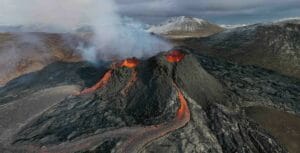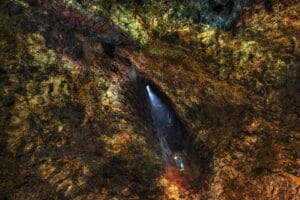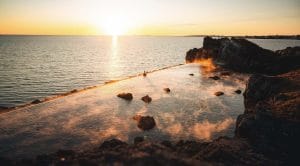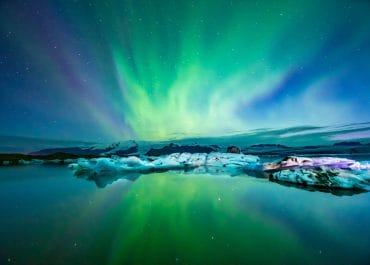Do you want to see and active volcano in Iceland? Following a restful period of 11 months, the Fagradalsfjall Volcano system has reawakened. It is essential to note that the eruption site is not a safe area. It is crucial to remain cautious as new fissures and craters may unexpectedly emerge at any location without prior warning.
Litli Hrútur Eruption in July 2023
Iceland Travel Guide, in collaboration with SafeTravel.is, is diligently working on creating an updated webpage to address your queries regarding the recent eruption.
The sight of a volcanic eruption is truly awe-inspiring, and Iceland is currently experiencing its third eruption along the same rift zone in as many years. Witnessing the mesmerizing flow of molten rock bursting forth from the Earth’s surface, as the land is divided by immense geological forces, is an unforgettable experience.
On Monday, July 10, at approximately 4:40 PM, magma plumes began ascending from a fissure stretching 900 meters in length, near the vicinity of Litli-Hrútur Hill. This new eruption is positioned slightly north of the previous two, aligning with scientific predictions based on meticulous surveys conducted in the area.
The eruption site is located approximately 30 kilometers (19 miles) southwest of Reykjavík and poses no threat to residential areas or infrastructure. Thankfully, there have been no reports of ash emissions or disruptions to international or domestic flights.
For real-time updates and an immersive experience, we invite you to explore the live stream available from RÚV, which offers a captivating glimpse of the ongoing volcanic activity.
Please remember to prioritize safety and adhere to any guidelines or warnings provided by local authorities. Keep yourself informed through the official channels and the forthcoming updated webpage, where you will find essential information to ensure a safe and enjoyable experience amidst this captivating natural phenomenon.
Visiting Litli-Hrútur Volcano Site in Iceland
Important Notice: Closure of Access to Eruption Site Until July 15
For the safety of all tourists and emergency responders, access to the eruption site is temporarily closed until July 15, as per the decision made by the police chief in Reykjanes. This precautionary measure aims to ensure the well-being of everyone involved. The situation will be reassessed on Saturday, and updates will be provided accordingly.
Great news! The Fagradalsfjall Volcano system has reawakened after an 11-month slumber. However, it’s important to remember that the eruption site is not safe. Unpredictable fissures and craters can emerge without any notice, so exercise caution and prioritize your safety.
For those seeking an extraordinary experience, the Litli Hrútur eruption site is now open for hikers (check updates regularly). The shortest hiking route is a 20 km (11 miles) round trip over rough terrain. Plan accordingly, as the hike can take approximately 6-8 hours, excluding the time spent at the site. Make sure you are well-prepared before embarking on this adventure.
Be Aware of Potential Hazards!
Near the eruption site, visibility may be limited, and dangerous gas levels can rapidly change, posing a risk to your well-being. Take these factors into account and be vigilant while exploring the area.
Prepare for a Safe and Enjoyable Visit!
To ensure a safe and memorable experience, it is recommended to be well-equipped and prepared for the hike. Stay updated with the latest safety guidelines and weather conditions. As always, prioritize your safety and follow any instructions from local authorities.
Embrace the Spectacle Safely! We understand the allure of witnessing a volcano in Iceland up close, but your safety is of utmost importance. Enjoy the awe-inspiring spectacle while staying aware of potential risks. Take this opportunity to create lasting memories, but always put safety first.
Prepare for a Safe and Enjoyable Visit
Near the eruption site, visibility may be limited, and dangerous gas levels can rapidly change, posing a risk to your well-being. Take these factors into account and be vigilant while exploring the area.
To ensure a safe and memorable experience, it is recommended to be well-equipped and prepared for the hike. Stay updated with the latest safety guidelines and weather conditions. As always, prioritize your safety and follow any instructions from local authorities.
Embrace the Spectacle Safely! We understand the allure of witnessing a volcano up close, but your safety is of utmost importance. Enjoy the awe-inspiring spectacle while staying aware of potential risks. Take this opportunity to create lasting memories, but always put safety first.
For a safe and enjoyable visit to the volcano in Iceland, we strongly recommend exploring it with a certified guide. These knowledgeable guides possess expertise about the area, maintain communication with authorities, and prioritize your safety throughout the excursion. With their guidance, you can rest assured that every precaution will be taken to ensure a secure and well-managed experience.
How to get there
Please note that the starting point of the hike will utilize the existing parking areas from the previous eruptions. It is not practical to walk or hike from Grindavík or Reykjavík to reach the eruption site. To access the volcano, it is recommended to utilize the designated parking areas and proceed with the appropriate hiking routes.
Drive to the volcano
To visit the volcano in Iceland, the recommended modes of transportation are through a guided tour or by car. The eruption site parking lot is situated roughly an hour away from Reykjavík and around 30 minutes from Keflavík Airport. Unfortunately, public transportation to the site is not available. For convenient parking, there are two paid parking lots, namely P1 and P2. The parking fee is 1,000 ISK and covers a 24-hour period. Electronic payment is accepted at the lots, and detailed instructions will be provided. P2 parking is highly recommended for this particular hike.
From Reykjavik
To reach the marked parking lots, follow these directions: Take road 41 in the direction of Keflavík. Then, turn onto road 43 towards Grindavík. Continue along road 427 until you spot the designated parking lots, which will be clearly marked for your convenience.
From Keflavik
For those looking to embark on a captivating Reykjanes circle tour, there are two routes available, both passing through Grindavík. Taking both routes will provide an exceptional and comprehensive experience, allowing you to explore the stunning attractions of the Reykjanes Peninsula from different perspectives.
Option 1: To reach the parking area, follow these directions. Take road 41 heading towards Reykjavík, then make a right turn onto road 43 towards Grindavík. Continue along road 427 until you spot the parking signs, guiding you to the designated area.
Option 2: For an alternative coastal route, follow these directions. Take road 41 towards Reykjavík, and then make a right turn onto road 44 towards Hafnir. Continue your journey on road 425, leading towards Grindavík. Finally, follow road 427 until you come across the marked car parks, indicating the designated parking area.
Parking at the volcano
Important Notice: Parking Regulations and Safety Precautions
Please be aware that parking along road 427 and off-road driving are strictly prohibited. The parking lots provided are situated on private land. To access the parking, a fee of 1,000 ISK is required, which can be conveniently paid electronically at Parka.is or by scanning the QR code available at the lot.
Kindly note that there are no services available at the eruption site. It is advisable to pack food and drinks accordingly or consider a pit stop in Grindavík before embarking on the trail to the eruption site.
Prioritize Safety: Inform Someone of Your Plans
For your safety, it is highly recommended to inform someone of your destination and expected return. You can accomplish this by filing a travel plan with Safetravel.is. This proactive measure ensures that there is awareness of your whereabouts and enhances overall safety during your journey.
Guided tours to the active volcano in Iceland
Discover the Best of the Volcano with Guided Tours!
You can find numerous tours to the volcano, offering you a chance to make the most of your experience while ensuring your safety. Opting for a local guide is highly recommended as they possess valuable insights and expertise.
Tour options may vary, some including transportation while others provide a meeting point at the parking area if you prefer to drive yourself. This flexibility allows you to choose the tour that suits your preferences and needs. Embark on a guided tour to enhance your understanding and enjoyment of this remarkable natural phenomenon.
Find guided volcano tours that are all operated by local guides here.
Helicopter Tours to see the active volcano in Iceland
Experience the Unforgettable: Aerial Views of an active volcano in a helicopter!
To truly make your visit extraordinary, consider booking a scenic helicopter flight for a bird’s eye view of the volcano. Witnessing the eruption from above is an awe-inspiring and unforgettable experience. To secure a seat, it is advisable to book your flight well in advance.
A helicopter tour will allow you to enjoy the breathtaking beauty of the volcano and its surroundings from a unique and exhilarating perspective.
Hiking to see the active volcano in Iceland
Hiking in Iceland requires proper preparation, regardless of the time or location. To ensure a safe and enjoyable experience, consider the following suggestions:
Dress appropriately: Iceland’s weather can be unpredictable. Wear layered clothing, including a waterproof outer layer, and sturdy footwear suitable for various terrains.
Carry essential gear: Bring a map, compass, and/or GPS device for navigation. Pack a first aid kit, extra food and water, a flashlight, and a whistle for emergencies.
Check the weather forecast: Prior to your hike, stay updated on the weather conditions. Be prepared for sudden changes and plan your route accordingly.
Inform someone: Let someone know your hiking plans, including your expected route, estimated duration, and when you plan to return. This ensures that someone is aware of your whereabouts.
Respect nature and wildlife: Preserve Iceland’s natural beauty by following Leave No Trace principles. Avoid disturbing wildlife and stay on designated paths to protect fragile ecosystems.
Be aware of daylight hours: Depending on the season, daylight hours can vary significantly in Iceland. Plan your hike accordingly, and be prepared for limited daylight during certain times of the year.
By heeding these suggestions and taking necessary precautions, you can fully enjoy the remarkable landscapes and trails that Iceland has to offer while prioritizing your safety.
Always be ready for cold, wet, windy, and potentially icy conditions, even if you start your hike in favorable weather.
What to pack for your hike - Gear Checklist
- Hiking boots (preferably above ankle)
- Waterproof shell jacket
- Layered clothing, including gloves/mittens and a neck warmer (choose wool or fleece, avoid cotton)
- Backpack
- Fully charged phone (consider bringing a power bank)
- Headlight/flashlight with spare batteries
- Sufficient food and water, accounting for longer durations than anticipated
- Hot beverages like coffee, tea, or hot chocolate to keep warm
- Practice Leave No Trace principles and take all waste with you
- Prepare for cold, wet, windy, and potentially icy conditions, even if starting the hike in good weather.
Safety at the volcano
Important Safety Information for Visiting the Eruption Site
With proper preparation and adherence to instructions, visiting the eruption can be done safely. Before your arrival, check safetravel.is for updates on the site’s accessibility, and follow the guidance provided by the authorities.
As with other areas in Iceland, the weather is a top concern. Located near the ocean, the eruption site is prone to rain, fog, and cold temperatures, which can change rapidly. Here are some vital points to remember:
Stay informed: Regularly check SafeTravel.is for detailed alerts regarding the eruption site and any other travel plans in Iceland.
Follow local authorities: Observe and comply with instructions given by local authorities and ICE-SAR members present at the site. Please note that the area may be closed on short notice for safety reasons.
Be cautious on lava: Avoid walking on both recent and cooled lava. Although it may appear cool and safe, lava can remain scorching hot beneath the surface for months or even years. It can crumble and create slippery and hazardous conditions. Falling on newly formed lava is extremely dangerous.
Expect weather changes: Weather conditions can quickly shift, so be prepared for cold, wet, windy, and icy conditions, even if your hike begins in good weather. Stay updated on the local weather forecast.
Earthquakes may occur: Be aware that the area is susceptible to further seismic activity, and additional earthquakes might take place.
By staying vigilant, following safety guidelines, and respecting the unpredictability of nature, you can enjoy your visit to the eruption site while prioritizing your well-being.
How long will the eruption last?
The duration of a volcano’s activity is highly unpredictable. However, Iceland’s geology has been extensively studied, revealing that the Reykjanes Peninsula has entered a new volcanic phase characterized by intermittent eruptions. This phase could span a significant period of 200-500 years. Historical records indicate that the peninsula was shaped by periods of intense volcanic activity followed by extended dormant periods, mirroring the current patterns observed in the region.
Volcanic Gases: Safety Precautions at the Litli-Hrútur Eruption
Authorities emphasize the utmost importance of taking extra precautions while hiking and closely monitoring the latest updates on weather conditions and volcanic gas emissions. Both the environment and the volcano can change rapidly, and hazardous conditions may prompt the closure of the area. Please exercise caution and stay informed to ensure your safety.
Photographing the volcano
Capture the Perfect Shot: Prioritize Safety and Awareness!
When seeking that perfect picture, remember to prioritize your surroundings before taking the shot. It’s important to be mindful of potential hazards, especially when it comes to the dynamic nature of lava.
While the allure of capturing the eruption from a drone’s perspective is undeniable, there are several risks to consider near the volcano. These include the presence of numerous drones in the area, low-flying manned aircraft, a high volume of visitors, and the proximity to an international airport. Additionally, the intense heat of the lava poses a risk of melting drones.
Drone operators are advised to stay informed about current regulations by monitoring the Icelandic Transport Authority and the Department of Civil Protection and Emergency Management. By being aware of the guidelines and safety measures, you can ensure a responsible and enjoyable experience while capturing stunning visuals of the eruption.
What to pack for your hike - Gear Checklist
Maximum Altitude: Ensure that your drone does not exceed an altitude of 120 meters (390 feet) above the ground while flying.
Give Way to Manned Aircraft: Always prioritize the safety of manned aircraft and yield the right of way to them when operating your drone.
Visual Line of Sight: Keep your drone within your visual line of sight at all times. Avoid flying beyond your direct vision range.
Caution Near Lava: Be mindful of flying too close to lava as it can result in the melting of your drone. Maintain a safe distance to prevent damage.
Additional Requirements for Commercial Drones: If you are operating a drone for commercial purposes, please ensure to check and comply with any additional requirements that may be applicable.
By adhering to these general drone rules, you can operate your drone responsibly and safely while respecting the airspace and ensuring an enjoyable experience for all.
Good to know
Stay Prepared for Changing Weather Conditions: Regardless of the initial weather conditions, be ready for cold, wet, windy, and potentially icy conditions during your hike.
Limited Facilities Available: Please be aware that there are no restroom facilities or services along the hiking route or at the eruption site. Plan accordingly and consider making necessary arrangements beforehand.
Beware of Volcanic Gases: During volcanic eruptions, harmful gases are released. These gases can be highly poisonous. Avoid low-lying areas in the landscape and if you experience any discomfort, leave the site immediately. It’s important to note that shifting winds can cause gases to move rapidly. Keep in mind that children may be more susceptible to the effects of these gases.
Observe Driving Regulations: Driving off-road or parking in unauthorized areas is strictly prohibited. Please adhere to designated parking locations and refrain from driving off established roads. Let’s respect the natural surroundings and ensure a safe and sustainable visit for everyone.






















































